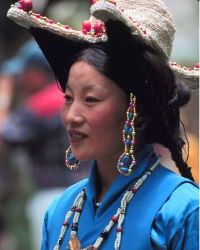Heinrich Harrier, famous for his book Seven Years in Tibet, walked through Khampa areas in the 1940s. Harrier described the Khampa: "They live in groups in three or four tents which serve as headquarters for their campaigns. Heavily armed with rifles and swords they force their way into a nomad's tent and insist on hospitable entertainment on the most lavish scale available. The nomad in terror brings out everything he has. The Khampas fill their bellies and their pockets and, taking a few cattle with them for good measure, disappear into the wide open spaces. They repeat the performance at another tent every day till the whole region has been skinned. Stories were told of the cruelty with which they sometimes put their victims to death. They go so far as to slaughter pilgrims and wandering monks and nuns."
The Northern Khampa are part of the Tibetan nationality in China. Anthropologist Michael Peissel described them in 1964: "The Khampas stood a good six feet in height wore great heavy boots and flowing khaki robes that flapped like whips as they walked, advancing with their feet slightly apart as if to trample the grass to extinction. Unlike Tibetans of Lhasa, their features were not Mongoloid."
Northern Khampa is one of three Khampa groups, "each speaking its own language and living in different areas. Due to the migration of peoples and the many political developments, Tibet has become very ethnically complex."
Khampa men are easily identifiable by the red and black tassels braided into their hair. They say that they wear this to protect their scalps during knife fights. Khampa superstition says a man without an earring will be reincarnated as a donkey. Turquoise, red coral, bone, and silver ornaments decorate nomad Khampa women's hair.
Although they profess to be Buddhists, the Khampa nomads' religion is little more than a crude imitation of the ideals of the pure form of Buddhism.
The Northern Khampa are separated by geographic, linguistic, cultural, and religious barriers. There has never been any kind of church or Christian witness in the extremely isolated and practically impenetrable Yushu Prefecture.
Without the guidance of Christ, these people will be lost in this life and the life to come. They need someone to go to them as Christ-bearers.
Pray for the spiritual blindness and bondage to the evil one to be removed so they can understand and respond to Christ.
Pray for the Lord to provide for their physical and spiritual needs as a testimony of his power and love.
Pray that the Khampa people will have a spiritual hunger that will open their hearts to the King of kings.
Pray for an unstoppable movement to Christ among them.
Scripture Prayers for the Khampa, Northern in China.
Operation China, Asia Harvest, Copyrighted © Used with permission
| Profile Source: Joshua Project |

























